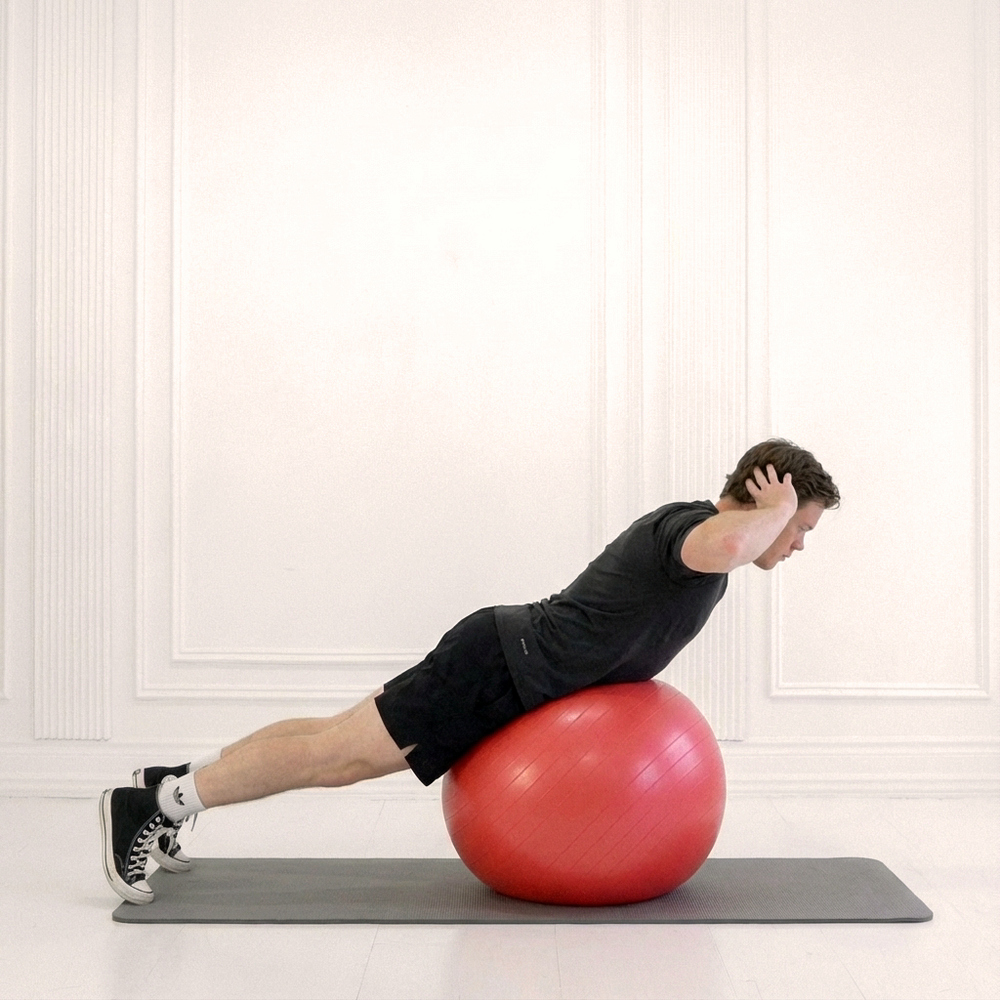
Video Coming Soon
We're working on adding video demonstrations for this exercise.
Stability Ball Back Extension and Twist
A stability ball exercise combining spinal extension and rotation that targets the erector spinae and obliques to build core stability and improve posture; suitable for all levels with optional weights for progression.
About Exercise
Equipment
Stability Ball
Difficulty
3/5 • Beginner
Primary Muscle Groups
Lower Back, Obliques
Secondary Muscles
Hamstrings, Abs
Popularity Score
6
Goals
Training Style
Setup Requirements
Requires Rack
No
Requires Bench
No
Requires Spotter
No
Space Needed
Medium
Noise Level
Low
Muscle Breakdown
View Muscle MapLower Back
9/10Erector Spinae
Obliques
8/10External Obliques, Internal Obliques
Glutes
6/10Glute Max
Hamstrings
5/10Biceps Femoris
Abs
4/10Rectus Abdominis
Programming
Typical Rep Range
8-15 reps
Rest Between Sets
30-60 seconds
How to Perform
Lie prone on a stability ball with hips and lower abdomen centered on top. Anchor feet against a wall or floor hip-width apart, hands behind head or crossed over chest.
- Lower torso slowly over the ball to feel a back stretch.
- Exhale and lift upper body using back muscles until body forms a straight line from head to heels.
- At peak extension, rotate torso slowly to one side from thoracic spine.
- Return torso to center while maintaining extension.
- Inhale and lower upper body controlled back over the ball.
- Alternate twist direction on next rep.
Coaching Tips
Form Cues
- Engage core throughout
- Twist from upper back
- Keep neck neutral
- Anchor feet firmly
- Avoid arching low back
Breathing
Exhale during lift and twist; inhale as you lower.
Tempo
3-2-1
Range of Motion
Start draped over ball with torso relaxed; extend to straight body line from head to heels; rotate torso 30-45 degrees each side without lumbar over-twist.
Safety
Safety Notes
- Use appropriate ball size for height
- Stop if lower back pain occurs
- Maintain control to prevent strain
- Focus thoracic rotation over lumbar
Spotting
Not required; use wall for foot anchor if needed for stability.
Common Mistakes
- Hyperextending lower back
- Twisting from hips
- Jerky movements
- Unsecured feet causing roll
When to Avoid
- Acute lower back pain
- Recent spinal injury
Flexibility Needed
- Thoracic spine rotation
- Hip flexion for ball positioning
Build Up First
- Basic core engagement
- Familiarity with back extensions
Also known as
Swiss Ball Back Extension with Rotation, Exercise Ball Back Extension Twist, Physio Ball Spinal Extension and Twist
Found this helpful?
Share your thoughts or help us improve this guide.
Similar Exercises

Stability Ball Back Extension
Stability Ball
Lower Back

Stability Ball Abdominal Twist
Stability Ball
Obliques

Stability Ball Russian Twist
Stability Ball
Obliques

Stability Ball Hyperextension
Stability Ball
Lower Back
Balance Trainer Back Extension
Balance Trainer, Stability Ball
Lower Back
Stability Ball Lift Superman
Stability Ball, Medicine Ball
Lower Back

Stability Ball Half Moon
Stability Ball
Obliques

Stability Ball Wall Squat
Stability Ball
Quads

Stability Ball V-Up
Stability Ball
Abs

Stability Ball Pike
Stability Ball
Abs


subscribe to our newsletter
Contact Us
hello@trainfitness.aiFind Us
130 Spadina Avenue, Toronto,
Ontario, M5V 0H4, Canada
©2025 All Rights Reserved
